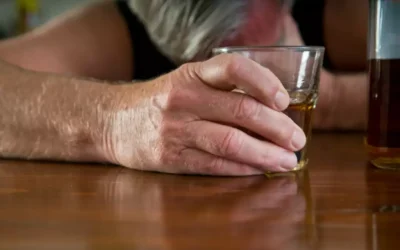Additional studies revealed that alcohol causes a concurrent, and perhaps compensatory, increase in salt and water transport across the epithelium. This transport is mediated by specific epithelial sodium channels located in the apical membrane and by protein pumps (i.e., Na/K-ATPase complexes) in the basolateral membrane of the epithelial cells. The expression and function of both the Na/K-ATPase complexes and epithelial sodium channels are increased in the alveolar epithelium of alcohol-fed animals (Guidot et al. 2000; Otis et al. 2008). Thus, as long as there are no additional stresses, the alcoholic lung seems to be able to limit edema formation by upregulating salt and water transport across the epithelium, thereby compensating for the marked increase in the leakage of fluid between cells (i.e., paracellular leakage) into the airways.
Impact on Respiratory Function
Study participants who had lower levels of the gas were also the excessive drinkers, while those who never drank had higher levels of nitric oxide. The more a participant reported drinking, the lower their levels, which told researchers that their bodies were less equipped to kill bacteria and fight off lung infections. Alcohol misuse — heavy daily drinking or binge drinking, which is drinking a lot in a short time — in general can harm healthy lungs, Jung says. People with alcohol use disorder, defined as problem drinking that’s become severe, are more likely to get lung infections or diseases such as pneumonia, tuberculosis, and other serious respiratory problems.
Alcohol is dangerous. So is ‘alcoholic.’
Defects in the function of the upper airway’s clearance mechanisms in alcoholic patients have been detected. Interestingly, Nrf2 also regulates the expression of PU.1, a master transcription factor that mediates GM-CSF–dependent signaling (Staitieh et al. 2015). Accordingly, alcohol-induced reduction of Nrf2 also inhibits binding of PU.1 to its nuclear targets, which can be improved by zinc treatment (Mehta et al. 2011). Thus, alcohol impairs how long does crack cocaine stay in your system epithelial barrier function in the lung through a complex set of mechanisms with several cycles and feedback mechanisms (see figure 2); however, future studies will almost certainly elucidate further details. Another key function of the alveolar epithelium, namely the synthesis and secretion of surfactant—which is required to maintain alveolar integrity and gas exchange—also is impaired by chronic alcohol ingestion (Holguin et al. 1998).
Finding treatment for alcohol use disorder
Experimental animal models of chronic alcohol ingestion demonstrated similar oxidation of the lung microenvironment. GSH levels were abrogated in the lungs and bronchoalveolar lavage (BAL) fluid of ethanol-fed rats (Holguin, Moss, Brown, & Guidot, 1998) and mice (Yeligar, Harris, Hart, & Brown, 2014). Collectively, these studies indicate that chronic alcohol abuse alters GSH homeostasis in the lung, leading to an increasingly oxidized pulmonary microenvironment.
Sexual and reproductive health
Chronic alcohol use can deplete the antioxidant glutathione, which plays a role in processing toxins and inflammation. Having low levels of glutathione in the body as a result of alcohol use can make the lungs more susceptible to injury after being exposed to bacteria. It can also affect liver function as a substance that is primarily produced in the liver.
We publish material that is researched, cited, edited and reviewed by licensed medical professionals. The information we provide is not intended to be a substitute for professional medical advice, diagnosis or treatment. It should not be used in place of the advice of your physician or other qualified healthcare providers. However, alcoholism wikipedia since the gag reflex does not work as well when someone is drunk, they might inhale these items into the lungs. “The steps we are recommending should not only help to align clinical practice with sound language guidelines, but also foster a more empathetic and supportive healthcare environment for patients,” he said.
The exact mechanism by which ethanol caused an apparent increase to central airway resistance (see Figures 5–6) in response to methacholine is unclear. The fact that ethanol exposure under these conditions did not affect basal indices of airway mechanics (Figure 4) speaks against potential physical causes of increase airway resistance, such as loss of tethering, edema and/or septal wall thickening (Bates, 2016). Ethanol exposure length (acute versus chronic) and timing (i.e., intoxication versus withdrawal) are known to have differing effects on neurotransmitter pathways in the both the CNS and in the periphery (Crews et al., 1996, Niebergall-Roth et al., 1998, Lajtha and Sershen, 2010). In the pancreas, although acute alcohol inhibits autonomic pathways, chronic exposure increases cholinergic tone via multiple mechanisms (Niebergall-Roth et al., 1998). Given the potential role of nicotinic and muscarinic receptors in airway hyperresponsiveness (Kolahian and Gosens, 2012), similar mechanisms could be at play in the lungs. Although some of the clinical impacts of alcohol consumption on the lung are welldescribed, mechanism(s) by which ethanol impacts pulmonary function are incompletely understood.
If you drink, you’ve probably had some experience with alcohol’s effects, from the warm buzz that kicks in quickly to the not-so-pleasant wine headache, or the hangover that shows up the next morning. Since those effects don’t last long, you might not worry much about them, especially if you don’t drink often. They can give you advice specific to you and your treatment plan and can help find the best ways for you to keep your COPD in check.
For example, Bouchard and colleagues (2012) showed that alcohol exposure triggered asthma-like pulmonary inflammation in an allergen-sensitized mouse model. These effects were not seen in mice that were exposed to alcohol but were not allergen sensitized, suggesting that alcohol can be an important trigger for airway reactivity in the context of an underlying allergic component. In contrast, Oldenburg and colleagues (2012) demonstrated that alcohol actually reduced airway hyperresponsiveness and airway inflammation in a mouse model of allergic asthma. Another fundamental component contributing to alcohol’s effects on the lungs is oxidative stress and the resulting alterations in alveolar macrophage function.
This is complicated by the fact that there are no feasible strategies to specifically block the actions of TGFβ1 in the clinical setting. Therefore, the current challenge is to identify other mechanisms of alcohol-mediated oxidative injury that are amenable to therapeutic intervention. As a first step to identify candidate genes that might explain how alcohol-induced oxidative stress renders the lung susceptible to acute lung injury, the authors compared lungs from control- and alcohol-fed rats using genetic analysis. In addition, the expression of a protein involved in immune system regulation, transforming growth factor β1 (TGFβ1), also was markedly increased in the alcohol-fed rat lungs (Bechara et al. 2004).
Although much of the attention concerning lung infections in people with AUD has been focused on bacterial infections, these individuals also have an increased susceptibility to viral airway infections. RSV is one of the most common lower respiratory tract viral pathogens and is a major cause of respiratory infections in children. Although RSV infections once were thought to be limited to children, it is now clear that RSV also is a serious problem in older people, patients with chronic obstructive pulmonary disease (COPD), and people with AUD.
- A study of ten older male patients with COPD, given a standard alcohol drink, found that exhaled Breathalyzer alcohol levels in the COPD patients did not correlate with BACs compared to the linear relationship of Breathalyzer levels with BACs in normal subjects (Russell and Jones, 1983).
- These findings indicate that brief exposure to alcohol stimulated ciliary motility both in vitro and in vivo.
- B cells are responsible for the second arm of the immune response (i.e., the humoral immunity) that is mediated not by specific cells but by immune molecules (i.e., antibodies) produced and secreted by B cells in response to exposure to a pathogen.
- If a person begins to worry about their drinking and its effects on their physical health, they can contact a doctor.
- Compared to non-alcoholics, patients with a history of alcohol abuse are twice as likely to develop sepsis, and those with sepsis are twice as likely to develop acute respiratory syndrome (ARDS) (Jong, Hsiue, Chen, Chang, & Chen, 1995; Joshi & Guidot, 2007; Moss, 2005).
Another fatal association between alcohol abuse and pneumonia was identified in a retrospective review of patients admitted with pneumococcal bacteremia that examined a subset with alcoholism and low white blood cell count (i.e., leukopenia) (Perlino and Rimland 1985). Ninety-three patients with pneumococcal bacteremia were identified, 12 of whom had a history of alcohol abuse and a white drugs brains and behavior blood cell count of less than 4,000 cells per cubic millimeter (mm3) of blood. Ten of these 12 (83.3 percent) patients died, whereas the mortality in the rest of the cohort was only 22 percent. Overall, these and other studies demonstrate the association between alcohol abuse and community-acquired pneumonia, an association that results in more severe infections and higher mortality.
This neutrophil-recruitment process is impaired by alcohol; even brief alcohol exposure decreases neutrophil recruitment to infected sites (Astry et al. 1983). For example, alcohol studies in rodents infected with aerosolized Staphylococcus aureus or Proteus mirabilis have demonstrated that alcohol intoxication decreases bacterial clearance in conjunction with decreased pulmonary neutrophil recruitment (Astry et al. 1983). Similarly, Boe and colleagues (2001) found that alcohol-exposed rats had decreased pulmonary neutrophil recruitment for up to 18 hours following S. Pneumoniae challenge; after that, however, neutrophil recruitment remained elevated even 40 hours post-challenge compared with nondrinking rats.…







